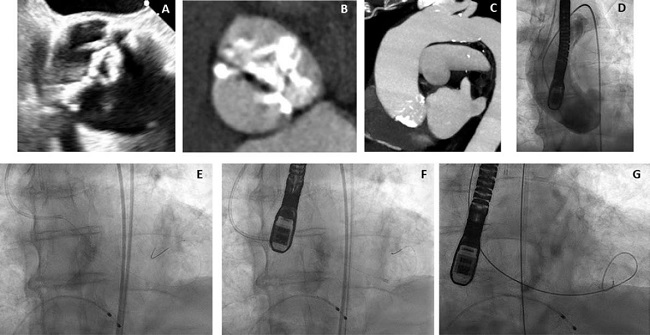My SciELO
Services on Demand
Journal
Article
Indicators
-
 Cited by SciELO
Cited by SciELO -
 Access statistics
Access statistics
Related links
-
 Cited by Google
Cited by Google -
 Similars in
SciELO
Similars in
SciELO -
 Similars in Google
Similars in Google
Share
REC: Interventional Cardiology
On-line version ISSN 2604-7276Print version ISSN 2604-7306
REC Interv Cardiol ES vol.5 n.4 Madrid Oct./Dec. 2023 Epub Mar 04, 2024
https://dx.doi.org/10.24875/recic.m23000378
Images in cardiology
New TAVI technique for difficult valve crossing
Servicio de Cardiología, Hospital Universitario Marqués de Valdecilla, Instituto de Investigación Sanitaria IDIVAL, Santander, Spain
This is the case of an 83-year-old man with symptomatic, severe aortic valve stenosis referred for transcatheter aortic valve implantation (TAVI). The echocardiogram revealed the presence of a severely calcified stenotic aortic valve (0.6 cm2) with bicuspid anatomy (figure 1A). The computed tomography scan revealed an Agatston calcium score of 17 727 (figure 1B), a 30 mm aortic annulus diameter, and dilated aortic root and aortic angulation > 70º (figure 1C). Aortography was performed (figure 1D).
Crossing the aortic valve with a guidewire for 60 min using catheters of various curves/sizes and several types of guidewires (with or without J-shaped tip, whether hydrophilic or not) was attempted by 2 highly skilled operators. Strategy, then, changed and a XB4 6F left coronary guide catheter (Cordis, United States) was used to manipulate a 0.014 inch hydrophilic Pilot 50 intracoronary guidewire (Abbott, United States) that easily crossed the aortic valve (figure 1E). A 6-Fr guide catheter extension system (Deeper, IHT-Cordynamic, Spain) was mounted on the wire and advanced to the left ventricular apex (figure 1F). Afterwards, the intracoronary guidewire was replaced by a 0.035 inch extra-stiff guidewire by removing both the guide and extension catheter systems (figure 1G). This original new approach took just 5 min.
The impossibility of crossing the aortic valve with a guidewire is rare. In our case the difficulty was due to a severely stenotic valve with massive calcification, bicuspid morphology, horizontal aorta, and dilatation of both the aortic root and the annulus.
This case is a truly original and novel technique, simple and safe, to achieve the guidewire crossing of a very stenotic aortic valve with a complex anatomy. This technique illustrates the cross-over use of coronary and structural interventional tools to solve complex problems.
Consent was obtained from the patient for the publication of this case.
Received: February 16, 2023; Accepted: March 24, 2023; pub: May 12, 2023











 text in
text in 



